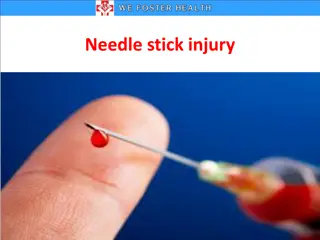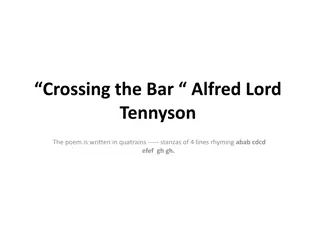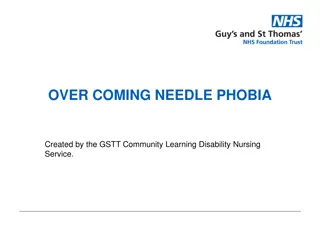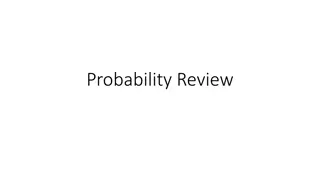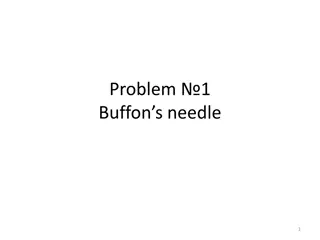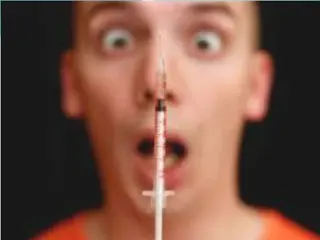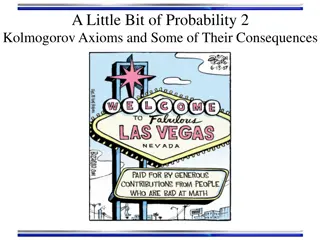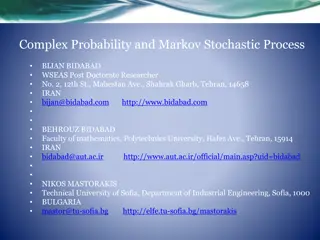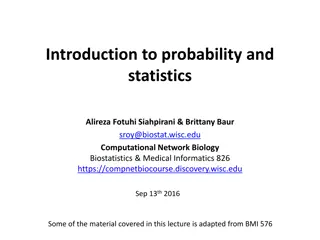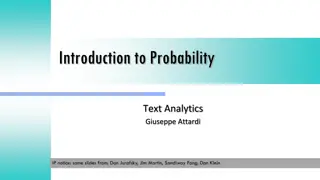Buffon's Needle Experiment: Probability Estimation through Sticks Crossing Lines
Buffon's Needle Experiment involves dropping sticks on parallel lines to estimate a mathematical constant through the frequency of the sticks crossing the lines. The experiment explores the theoretical introduction, probability calculations, equipment setup, and hypotheses related to accuracy and precision. Through simulations and results comparison, the experiment aims to determine the accuracy achievable and how various factors impact the outcomes.
Uploaded on Sep 15, 2024 | 0 Views
Download Presentation

Please find below an Image/Link to download the presentation.
The content on the website is provided AS IS for your information and personal use only. It may not be sold, licensed, or shared on other websites without obtaining consent from the author. Download presentation by click this link. If you encounter any issues during the download, it is possible that the publisher has removed the file from their server.
E N D
Presentation Transcript
1. BUFFONS NEEDLE TeamCroatia Reporter:Marko ari
1. BUFFONS NEEDLE Draw a series of parallel equally spaced lines on a horizontal surface. Pick a bunch of sticks (e.g. matches or needles) slightly shorter or longer than the separation between the lines, and randomly drop them on the surface. It is claimed that the number of times the sticks cross the lines allows estimating the constant to a high precision. What accuracy can you achieve? 2
OUTLINE Theoreticalintroduction Probability of crossing the line Experiment Equipment Changing needle-track ratio Group vs. Single stick Height testing Program simulations Results Comparison of results 4
PROBABILITY OF CROSSING THE LINE a= stick lenght Two parallel lines ?1, ?2with distance b ? < ?,? = ?,? > ?. ?sin Probability of crossing one line x 2 Whether the stick cross the line depends of: distance d angle 5
PROBABILITY OF CROSSING THE LINE ? = ,? :0 ?,0 ? ?,? < ?sin? ? = ,? : ? ?,0 ? ? ? ? 2 ? ?? b ?? ? ??= ??? ??= ?? 6
PROBABILITY OF CROSSING THE LINE Provided that ? < ?sin stick will cross the line. ? =?? 2? 2??= ? ?? 2S =2? ?sin ??= ?? ? =2?? ?? ? =??? ? ????? ?????? ?? ? ???? ?????? ?? ? ? ? ?????? ?? ?????? ???????? ? ? ???? ? ???? ? ?? ? ? ????? ? ? ? ???????? ??????? ? ? ????? 7
HYPOTHESES 1 Deviation will decrease by increasing number of throws. Const. ? ? =?? ? ? ? ? 1,? 8
HYPOTHESES 1 Deviation will decrease by increasing number of throws 2 Single stick throwing is better than group throwing 3 Height will not affect accuracy of results 4 Approximation accuracy will not depend of needle-track ratio (a/b) 9
EXPERIMENTAL SETUP 2700 matches one by one 40cm parallel to the floor a=9.5cm b=10 cm, 9.5cm, 9 cm Distance betwen lines (b=10cm) Stick lenght (a=9,5cm) 10
CHANGING A:B RATIO ? ????? ?????? ?? ? ???? ?????? ? ? ? ?????? ?? ?????? ???????? ? ? ???? ? ???? ? ?? ? ? ????? ? ? ? ???????? ??????? ? ? ????? ? =2?? ?? ideally 0 X - deviation from ? ? < ? ? = 10?? ? = 0,148593... ? > ? ? = 9?? ? = 0,082011 ? = ? ? =2? ? = 0,00023140 ? 11
Change of absolute deviation with number of sticks number of throws deviation 0,4 n vs a>b n vs a<b n vs a=b smallest deviation a=b the biggest deviation a<b 0,3 Absolute deviation 0,2 0,1 Hypothesis 1 0,0 0 500 1000 1500 2000 2500 Number of sticks - n 12
Simulation - Change of absolute deviation with number of sticks 0,35 Smallest deviation a=b The biggest deviation a<b Simulation fits experimental results a<b a=b a>b 0,30 0,25 Absolute deviation 0,20 0,15 0,10 0,05 0,00 0 500 1000 1500 2000 2500 Number of sticks - n 13
GROUP VS. SINGLE STICK I thrown sticks all at once from height of 40 cm and compared results with throwing one by one. Hypothesis 2 14
HEIGHT TESTING Two heights 20 cm, 40 cm Height does not affect accuracy of results 15
HIGHT EQUAL TO STICK LENGHT Height stick lenght inaccurate results Then we are controling will stick cross the line or not. Hypothesis 3 16
DEPENDANCE ON THE NEEDLE-TRACK RATIO (A/B) The Approximation of p Depending on the Needle - Track Ratio (for 106 throws) 3,20 The program variates the needle length 3,18 3,16 Approximation of p 3,14 The track width is constant 3,12 3,10 a<b a>b Approximation accuracy will not depend of needle-track ratio (a/b). 3,08 3,06 0 1 2 3 4 5 Needle - Track Ratio Hypothesis 4 17
CONCLUSION 1 Deviation will decrease by increasing number of throws. 2 Single stick throwing is better than group throwing. 3 Height will not affect accuracy of results. Height stick lenght Height > stick lenght 4 Approximation accuracy will not depend of needle-track ratio (a/b). 18
LITERATURE http://www.mathematica- journal.com/issue/v11i1/contents/BuffonsNeedle/Buffons Needle.pdf (4.11.2017) http://mis.element.hr/fajli/560/09-04.pdf (4.11.2017) https://web.math.pmf.unizg.hr/nastava/uuv/files/ch5.pdf (4.11.2017) https://www.cut-the-knot.org/fta/Buffon/buffon9.shtml (10.11.2017) 19
THANK YOU! TeamCroatia Reporter:Marko ari
Way of throwing Totalnumber ofthrownstic ks/n Numberofsti ckscrossingth eline/m ? Estimate ? All at once 2700 1835 2.7715... Oneby one 2700 1693 3.0301... Height Totalnumberoft hrownsticks/n Numberofsticksc rossingtheline/ m ? Estimate ? 20 cm 2700 1712 2.9965... 40 cm 2700 1693 3.0301... ? > ? m= 1863 ? = 9?? ? = 0,082011 ? = ? ? =2? ? = 1719 ? = 0,00023140 ? < ? m= 1714 ? = 10?? ? = 0,1114686... ? 23
DEPENDANCE ON THE NUMBER OF THROWS The Approximation of p Depending on the Number of Tosses 5 The program variates the number of throws of the needle 4 It repeats the experiment for 1, 5,10, 25, 50, 75, 100, 250, 500, 750 and1000 throws Approximation of p 3 2 0 200 400 600 800 1000 Number of Tosses 24
PROGRAMMING In order to completely randomize the fall of the needle, I devised a program in the programming language Python The program randomises the position between two lines where the needle must fall and its orientation when it falls These values manifest as the minimal distance of the needle from the line and the angle between the needle and the line The action of falling is repeated a thousand times 26





